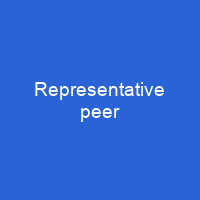representative peers were elected by the members of the Peerage of Scotland and the Peerages of Ireland to sit in the British House of Lords. In 1999, a new form of representative peer was introduced to allow some hereditary peers to stay in the Lords. The system of electing representative peers was abolished as well as Scottish peers and their automatic right in the Upper House with the House Of Lords Act 1999.
About Representative peer in brief

The Lord Clerk Register was responsible for tallying the votes. The return issued by the Lord Clerk register was sufficient evidence to admit the representative peers to Parliament; however, unlike other peers, Scottish representatives did not receive writs of summons. The same procedure was used whenever a vacancy arose. The block voting system was used, with each peer casting as many votes as there were seats to be filled. The party with the greatest number of peers, normally the Conservatives, to procure a disproportionate number of seats, with opposing parties sometimes being left entirely unrepresented. Those chosen by Scotland sat for the life of one Parliament, and following each dissolution new Scottish peers wereelected. In contrast, Irish representative peers sat for life. Elections for Irish peers ceased when the Irish Free State came into existence as a Dominion in December 1922. However, already-elected Irish peers continued to be entitled to sit until their death. They were allowed to elect sixteen representative peers, while Ireland could elect twenty-eight. Each served for one Parliament or a maximum of seven years, but could be re-elected during future Parliaments. The elections were held in a large room decorated by eighty-nine of Jacob de Wet’s portraits of Scottish monarchs, from Fergus Mór to Charles II.
You want to know more about Representative peer?
This page is based on the article Representative peer published in Wikipedia (as of Nov. 14, 2020) and was automatically summarized using artificial intelligence.







